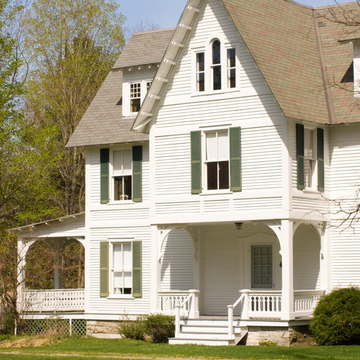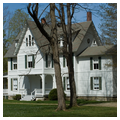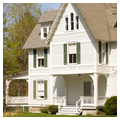This two-story, wood-frame “cottage,” just west of Dorset's linear village green, is an important early example of Stick Style and indicates the wider cultural influences second-home development introduced to Vermont after the Civil War. It was built for New Yorkers George L. Prentiss, a prominent Presbyterian divine and professor at Union Theological Seminary, and his wife, author Elizabeth Payson Prentiss, most noted for Stepping Heavenward (1869). The Prentiss family took room and board in Dorset during a summer trip in 1867 and became enchanted with the woods and modesty of rural prospects. Two years later they chose Dorset over Williamstown, Massachusetts, as the location for their summer house. Their cultural sophistication undoubtedly influenced the unknown architect who designed in the picturesque style of A. J. Downing and Calvert Vaux of the 1850s.
However, the house's verticality and eclectic detailing, including a tall Palladian window in the gable of the entrance pavilion; stickwork panels within a double belt course; and scroll-sawn porch ornament indicate the latest in Stick Style fashion, similar to detailing in George W. Woodward's published designs, and based on the domestic designs of George Devey and Richard Norman Shaw in England, where the Prentisses had spent more than a decade. Such styling did not appear in Vermont and rarely elsewhere until after it was popularized by the 1876 Philadelphia Centennial Exposition. The Prentisses chose a site at the edge of a village, which for them was decidedly rural. The cottage is placed well back from the road, originally at the end of a serpentine drive, well beyond the setback of the buildings that line the north side of the village green. Largely unchanged since Elizabeth's death here in 1878, the cottage has remained in the family.


















